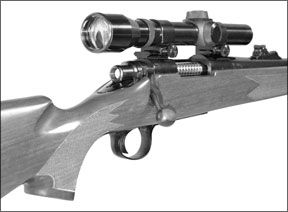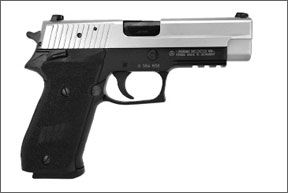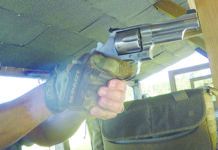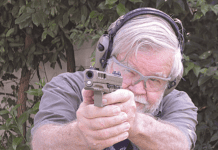Re "All-Around .35-Calibers: We Pit
Remington’s CDL Vs. the BDL," August 2007
I liked your article regarding the CDL versus BDL, but it is too bad you could not find an "actual" BDL in the .350 Rem. Mag. The rifle you used appears to be a Remington Model 700 Classic. Although the BDL and the Classic are basically the same thing as far as the action, barrel, and sights go, the stock design and finish are different.
288
I realize it is easier to call the Classic "a BDL without the fore-end cap," than it is to explain that you could not find an "actual" BDL in very good condition in a caliber that would have worked for the specific test you ran. Also, the explanation of the differences, no matter how slight they are, may have wasted print space. Nonetheless, good article.
How about an article comparing the Kimber M84 or Montana Rifle in .338 Federal to any other in that caliber, such as Ruger’s new Hawkeye or the Tikka offering? Also, I would find it interesting if you compared the .338 Federal to the .35 Whelen or .358 Winchester in future articles.
—Jeff Nelson
Montana
Thanks for the info on the Remingtons. The Remington website does not have much in the way of explanation on older models, so it is from knowledgeable folks like yourself that our readers can gain insight. The test rifle was about 20 years old, and was the only thing we could find in that caliber. We in fact have a test upcoming on the Kimber Montana in .338 Federal against the new Sako Model 85 in the same caliber. I in fact had planned a test between the .35 Whelen, the .338 Federal, and the .358 Winchester with an eye to comparing the calibers, but could not gather the rifles in a timely manner.
—Ray Ordorica
I thought the SPS replaced the ADL, not the CDL. The CDL is way out of the price range of the ADL, while the SPS is a lot closer.
—Steve Lindsey
Re "Two Affordable Side-By-Sides
Earn Our Praise for Field Work," August 2007
I just finished reading your test on affordable side-by-side shotguns. It was as usual, a fine piece of work. However, I’ve got to take you to task on one point; you left off a key firearm—the Ruger Gold Label. I bought mine new two summers ago for $1799. I’ve had it afield for hundreds of birds and maybe a couple of thousand clay birds on the trap and skeet range, and I have found it to be the equal of many higher-priced guns. This is coming from a 51-year-old who has owned or fired just about any make of fine double you can imagine. The Ruger is very light, under 6 pounds, fast handling, well balanced, and it comes with removable choke tubes. My only two complaints have been that the ejectors foul and refuse to eject on occasion and I really wish it had a double trigger for aesthetics rather than function.
This gun cost me a full $1000 less than the Weatherby you tested and almost $2K less than the Beretta. You can’t beat that with a stick. Now, if only it came in 20 or 16 gauge. So, just for the record, why didn’t you include it?
—R. J. Talley
288
Well, we haven’t ignored the Ruger Gold Label. In the October 2005 issue, in "Ruger’s Gold Label Takes On British 12-Bore Game Guns," Ray Ordorica compared the Ruger very favorably to a variety of imports. We gave the Ruger Gold Label, $2000, a "Buy It" recommendation at the time. We said, "The Ruger Gold Label is not an English game gun, but has many of the right features. For us, it threw its charges quite high, which some shooters prefer. It had zero cast, a 1.5-inch drop at comb, and a 2-inch drop at heel. We think it’ll satisfy nearly anyone who wants a good, light, side-by-side 12 gauge for whatever reason. We consider the Ruger to be probably the finest U.S.-made shotgun ever produced, and it’s far and away the best U.S. double gun made today."
—Todd Woodard
Re " Full-Sized Tactical .45s with Accessory
Rails: Buy the TRP," August 2007
I find it curious that a successor to the .45 pistol you chose as Best in Class ‘05 is rated a "B" in your most recent test—especially when compared to two 1911-style .45s. It appears that you downgraded the Sig P220 primarily based on its lighter weight, and consequently greater felt recoil when firing heavier-weight .45 ACP ammunition. That seems a harsh judgment for arguably the most

288
accurate and least expensive gun in the group. Add its ease of takedown and carry comfort, and it is difficult for me to concur with your conclusion. Your speculation that the P220 might be somewhat more fragile than the 1911 may have some validity, but the 1911 was designed to compete in military trials that place a premium on robustness and the ability to take abuse. It is highly unlikely that any civilian would subject his or her handgun to the rigors of military combat.
From my perspective, your review is a classic case of comparing apples to oranges. The Sig P220 is more comparable to an alloy-framed commander-sized 1911 or an H&K USP compact (which you praised for its light weight) in .45 ACP. A side-by-side comparison of those firearms would be relevant, consistent, and useful. If you had wanted to compare a Sig pistol to the Springfield Armory TRP and Kimber TLE RL II, you should have chosen the Sig GSR.
—Bill Craig
Madison, Virginia
As noted in the text of the article, this match-up was in response to a specific request from a subscriber. The P220 previously tested does not match up in any way other than caliber with the Kimber and Springfield Armory 1911s. The match-up in this latest case is not an apples-to-oranges comparison as you suggest. When Sigarms began selling the P220 SAO, a single-action-only single-stack .45 with thumb safeties and accessory rail, the gun instantly competed with all the currently available 1911s equipped with a rail. The key issue here is that when it comes to the purpose and application of the product, the P220 SAO is vying for the same dollar as Kimber, Springfield Armory, and other pistol makers.
—Roger Eckstine
Re "Used Shotguns: Which Pumps Should You
Buy? — And Avoid?" July 2007
A bit of comment on the Winchester 1200: Ralph Winingham had it just about right as to the pointability and feel of this shotgun. However, this gun does have one other sterling characteristic—ease of takedown and maintenance.
I acquired a used 1200, just like the one you had pictured with a 28-inch plain barrel in the early 1970s when I was a struggling college kid. I was doing a lot of snipe and waterfowl hunting back then, and because of its easy takedown, the 1200 quickly became my shotgun of choice for this type of hunting, although I had a couple of semi-autos available.
Ralph was also correct about the slide release of the 1200, for a right-hander. Being left-handed, however, this worked fine for me.
—John Dean
Lakeland, Florida
GUN_TESTS_WELCOMES_MAIL_0907.pdf























